Academic writing The Structure of Course:

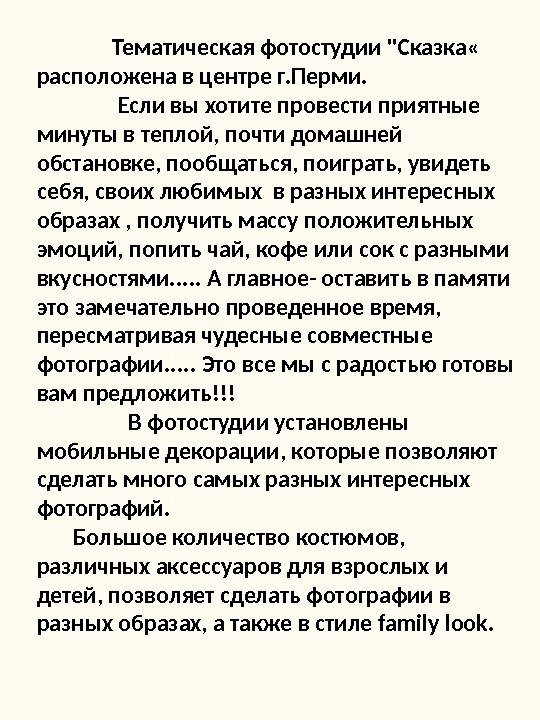


















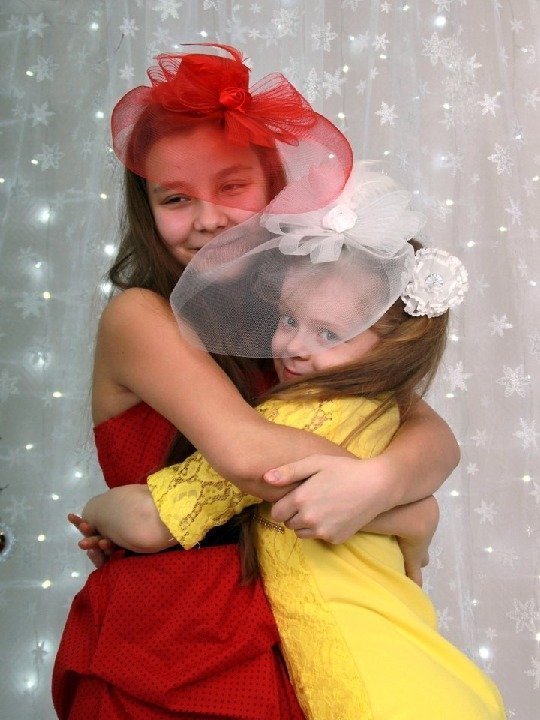






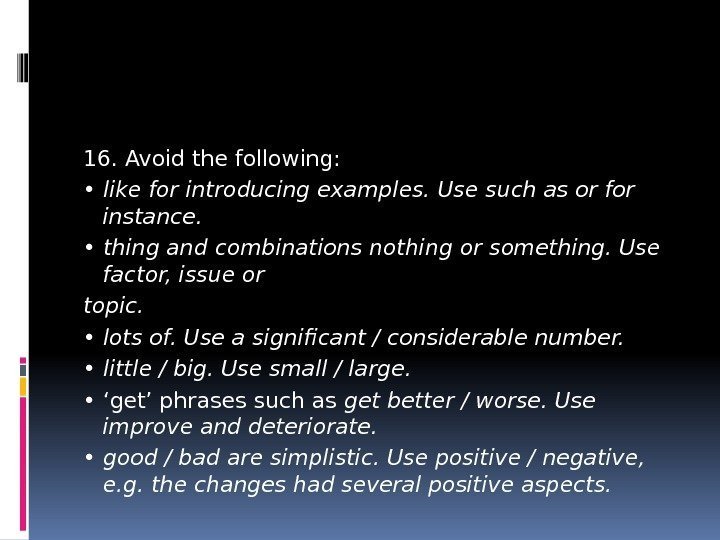
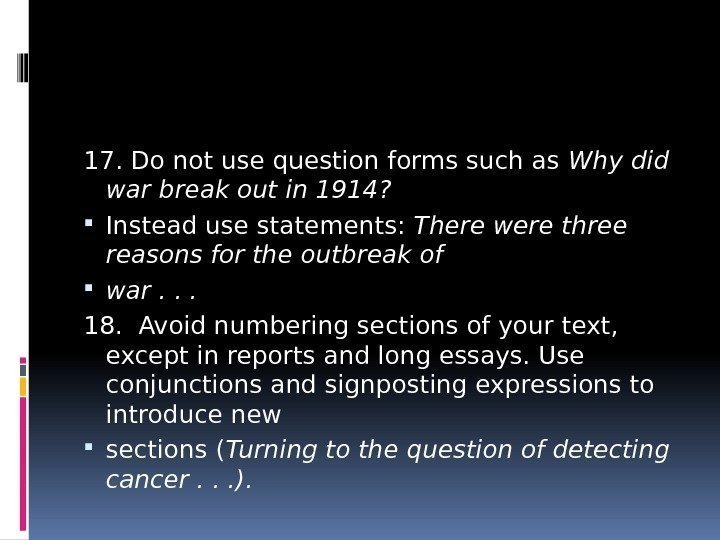
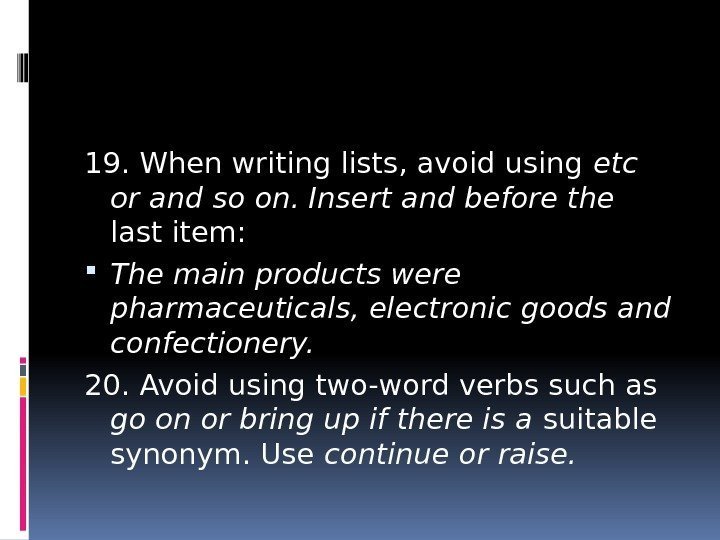

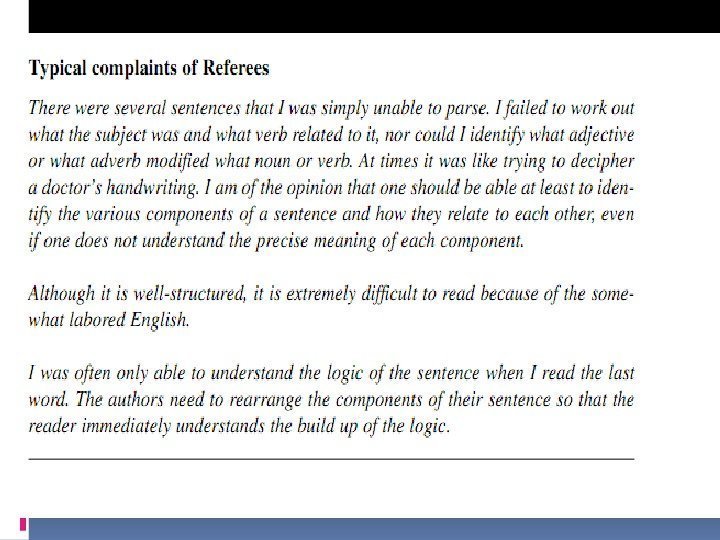
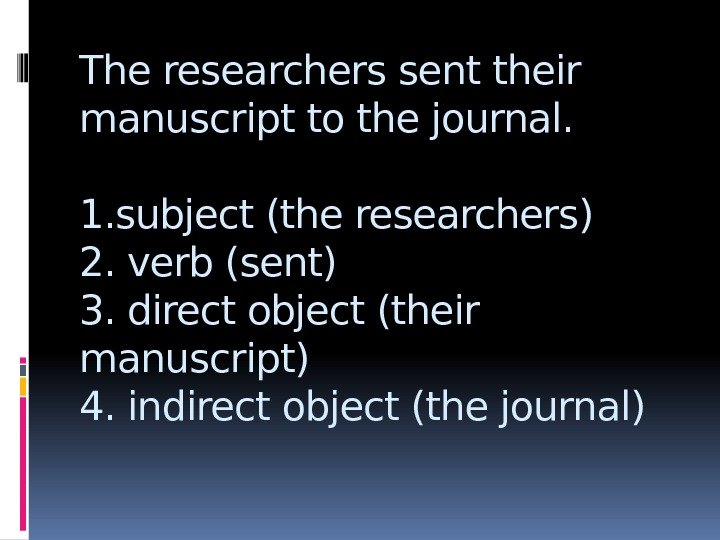
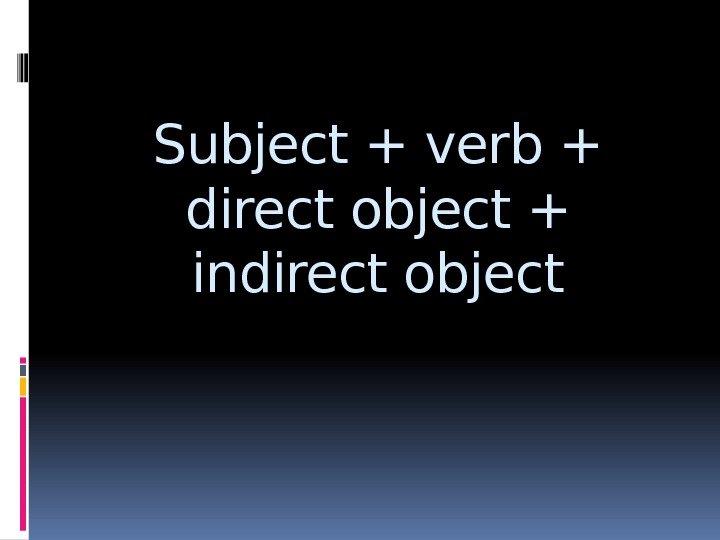
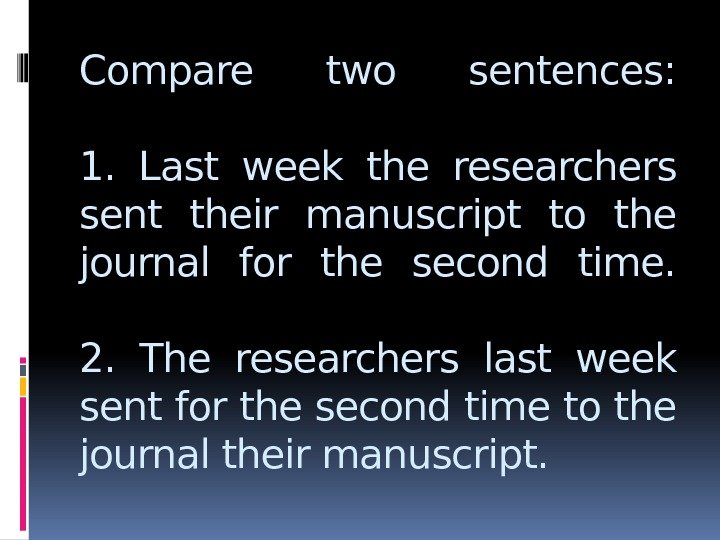
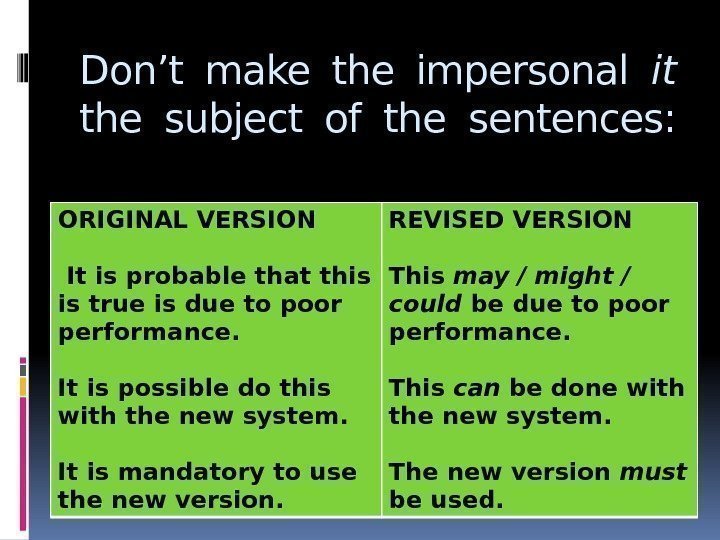
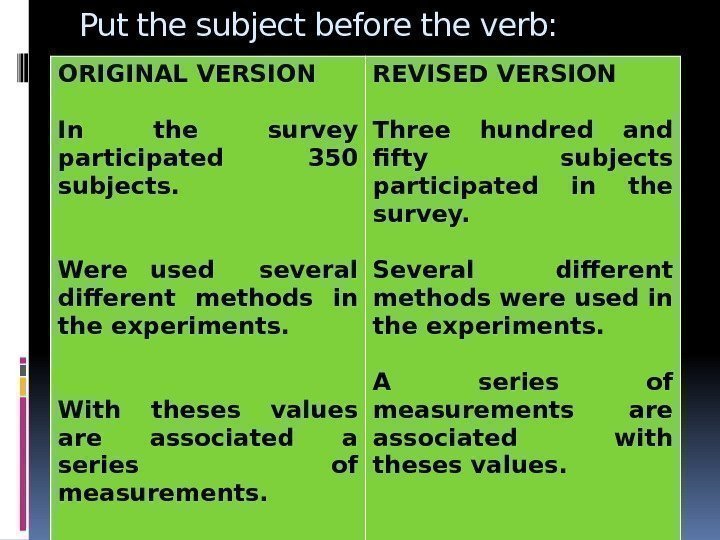
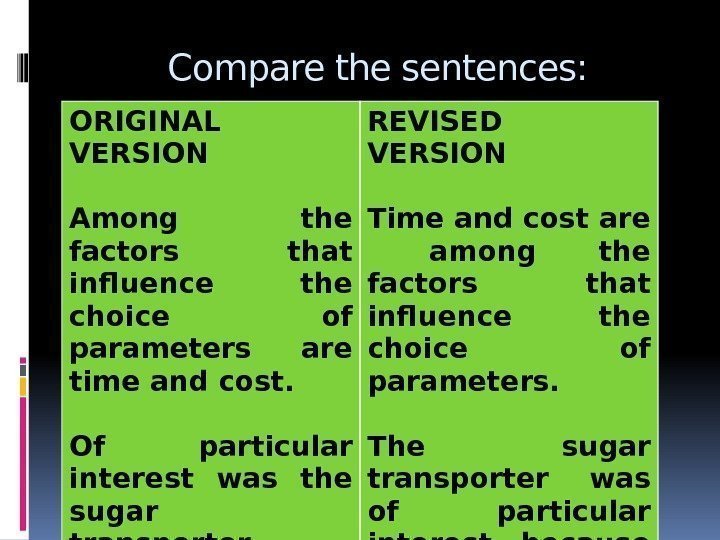

prezentaciya1.pptx
- Размер: 1.2 Мб
- Автор:
- Количество слайдов: 39
Описание презентации Academic writing The Structure of Course: по слайдам
 Academic writing
Academic writing
 The Structure of Course: Stylistic features of Scientific English Punctuation and spelling Capitalization Word order Writing paragraphs Link words: connecting phrases and sentences together Paraphrasing and avoiding plagiarism Defining, comparing, evaluating and highlighting Writing references Visuals (tables, graphs, Diagrams) Quotation
The Structure of Course: Stylistic features of Scientific English Punctuation and spelling Capitalization Word order Writing paragraphs Link words: connecting phrases and sentences together Paraphrasing and avoiding plagiarism Defining, comparing, evaluating and highlighting Writing references Visuals (tables, graphs, Diagrams) Quotation
 Jordan R. R. Academic Writing Course. Edinburg: Longman, 1996. Maclin A. Reference Guide to English: a Handbook of English as a Second Language. Washington: s. n. , 1996. Swales M. J. Academic Writing for Graduate Students: Essential Tasks and Skills. Ann Arbor: the University of Michigan press, 1997. Wallwork, Adrian. English for Presentations at International Conferences. Springer, 2010. Wallwork, Adrian. English for Academic Correspondence and Socializing. Springer, 2009. Wallwork, Adrian. English for Research: Usage, Style, and Grammar. Springer, 2011. Wallwork, Adrian. English for Academic Research: Grammar Exercises. Springer, 2012. Wallwork, Adrian. English for Academic Research: Vocabulary Exercises. Springer, 2010. Wallwork, Adrian. English for Academic Research: Writing Exercises. Springer, 2011.
Jordan R. R. Academic Writing Course. Edinburg: Longman, 1996. Maclin A. Reference Guide to English: a Handbook of English as a Second Language. Washington: s. n. , 1996. Swales M. J. Academic Writing for Graduate Students: Essential Tasks and Skills. Ann Arbor: the University of Michigan press, 1997. Wallwork, Adrian. English for Presentations at International Conferences. Springer, 2010. Wallwork, Adrian. English for Academic Correspondence and Socializing. Springer, 2009. Wallwork, Adrian. English for Research: Usage, Style, and Grammar. Springer, 2011. Wallwork, Adrian. English for Academic Research: Grammar Exercises. Springer, 2012. Wallwork, Adrian. English for Academic Research: Vocabulary Exercises. Springer, 2010. Wallwork, Adrian. English for Academic Research: Writing Exercises. Springer, 2011.
 • Mauranen, A. Cultural Differences in Academic Rhetoric. Frankfurt am Main: Peter Lang , 1993. • Swales, J. M. Genre Analysis: English in Academic and Research Settings. Cambridge: Cambridge University Press , 1990. • Swales, J. M. , and C. B. Feak. Academic Writing for Graduate Students: A Course for Nonnative Speakers of English. Ann Arbor: University of Michigan Press, 1994. • Swales, J. M. , and. C. B. Feak. English in Today’s Research World: A Writing Guide. Ann Arbor: University of Michigan Press, 2000. • Thompson, G. , and Y. Yiyun. Evaluation in the reporting verbs used in academic papers. Applied Linguistics, 1991. • Weissberg, R. , and S. Buker. Writing up Research: Experimental Research Report Writing for Students of English. Englewood Cliffs, N. J. : Prentice Hall, 1990. • Yakhontova, T. Selling or telling? The issue of cultural variation in research genres. In Academic Discourse, J. Flowerdew (Ed. ), 216 -232. London and New York: Longman, 2002.
• Mauranen, A. Cultural Differences in Academic Rhetoric. Frankfurt am Main: Peter Lang , 1993. • Swales, J. M. Genre Analysis: English in Academic and Research Settings. Cambridge: Cambridge University Press , 1990. • Swales, J. M. , and C. B. Feak. Academic Writing for Graduate Students: A Course for Nonnative Speakers of English. Ann Arbor: University of Michigan Press, 1994. • Swales, J. M. , and. C. B. Feak. English in Today’s Research World: A Writing Guide. Ann Arbor: University of Michigan Press, 2000. • Thompson, G. , and Y. Yiyun. Evaluation in the reporting verbs used in academic papers. Applied Linguistics, 1991. • Weissberg, R. , and S. Buker. Writing up Research: Experimental Research Report Writing for Students of English. Englewood Cliffs, N. J. : Prentice Hall, 1990. • Yakhontova, T. Selling or telling? The issue of cultural variation in research genres. In Academic Discourse, J. Flowerdew (Ed. ), 216 -232. London and New York: Longman, 2002.






 Scientific journals Web of Science Scopus Web of Knowledge Astrophysics Pub. Med Mathematics Chemical Abstracts Springer
Scientific journals Web of Science Scopus Web of Knowledge Astrophysics Pub. Med Mathematics Chemical Abstracts Springer
 Scopus and Web of Science the largest abstracts and citation databases of peer-reviewed research literature with over 42, 000 titles from more than 10, 000 international publishers.
Scopus and Web of Science the largest abstracts and citation databases of peer-reviewed research literature with over 42, 000 titles from more than 10, 000 international publishers.
 Scopus and Web of Science subject coverage span many discipline areas: Agricultural and Biological Sciences Arts and Humanities Biochemistry, Genetics and Molecular Biology Business, Management and Accounting Chemical Engineering Chemistry Computer Science Decision Sciences Dentistry Earth and Planetary Science Economics, Econometrics and Finance Energy Engineering Environmental Science Health Professions Immunology and Microbiology Materials Science Mathematics Medicine Multidisciplinary* Neuroscience Nursing Pharmacology, Toxicology and Pharmaceutics Physics and Astronomy Psychology Social Sciences Veterinary
Scopus and Web of Science subject coverage span many discipline areas: Agricultural and Biological Sciences Arts and Humanities Biochemistry, Genetics and Molecular Biology Business, Management and Accounting Chemical Engineering Chemistry Computer Science Decision Sciences Dentistry Earth and Planetary Science Economics, Econometrics and Finance Energy Engineering Environmental Science Health Professions Immunology and Microbiology Materials Science Mathematics Medicine Multidisciplinary* Neuroscience Nursing Pharmacology, Toxicology and Pharmaceutics Physics and Astronomy Psychology Social Sciences Veterinary
 The impact factor (IF) of an academic journal is a measure reflecting the average number of citations to recent articles published in the journal. It is frequently used as a proxy for the relative importance of a journal within its field, with journals with higher impact factors deemed to be more important than those with lower ones.
The impact factor (IF) of an academic journal is a measure reflecting the average number of citations to recent articles published in the journal. It is frequently used as a proxy for the relative importance of a journal within its field, with journals with higher impact factors deemed to be more important than those with lower ones.

 Directory of Open Access Journals (DOAJ) www. DOAJ. org DOAJ is an online directory that indexes and provides access to quality open access, peer-reviewed journals.
Directory of Open Access Journals (DOAJ) www. DOAJ. org DOAJ is an online directory that indexes and provides access to quality open access, peer-reviewed journals.
 The Structure of Research Paper Introduction Materials and Methods Results Discussion and Conclusions Title Author names and affiliations Abstract Keywords References
The Structure of Research Paper Introduction Materials and Methods Results Discussion and Conclusions Title Author names and affiliations Abstract Keywords References


 Just two or three badly constructed sentences may be enough for referees to initially recommend rejecting a paper and suggest having the English revised.
Just two or three badly constructed sentences may be enough for referees to initially recommend rejecting a paper and suggest having the English revised.
 Features of academic writing Complexity Formality Objectivity Explicitness Accuracy Responsibility
Features of academic writing Complexity Formality Objectivity Explicitness Accuracy Responsibility
 CHECKLIST OF LANGUAGE TO AVOID IN ACADEMIC WRITING 1. Phrasal or prepositional verbs: Research expenditures have gone up to $ 350 million. → have increased 2. Contractions: The experiment won’t be over until the end of the year. → will not 3. Informal negative forms: not…any → no not…much → little not…many → few This approach does not promise many innovations. → few
CHECKLIST OF LANGUAGE TO AVOID IN ACADEMIC WRITING 1. Phrasal or prepositional verbs: Research expenditures have gone up to $ 350 million. → have increased 2. Contractions: The experiment won’t be over until the end of the year. → will not 3. Informal negative forms: not…any → no not…much → little not…many → few This approach does not promise many innovations. → few
 4. Adverbs in the initial or final positions: The result can be seen easily. → can be easily seen 5. Direct questions: What should we do to improve the ecological situation? → We need to consider what we should do to improve the ecological situation. 6. “Run-on” expressions (“and so forth”, “etc. ”): These semiconductors can be used in robots, CD-players , etc. → These semiconductors can be used in robots, CD-players, and other electronic devices.
4. Adverbs in the initial or final positions: The result can be seen easily. → can be easily seen 5. Direct questions: What should we do to improve the ecological situation? → We need to consider what we should do to improve the ecological situation. 6. “Run-on” expressions (“and so forth”, “etc. ”): These semiconductors can be used in robots, CD-players , etc. → These semiconductors can be used in robots, CD-players, and other electronic devices.
 7. Colloquial abbreviations and shortened words: TV→ television, ’ cause → because, fridge→ refrigerator. 8. Meaningless, vague, simplistic and/or weak words: ” very”, “really”, “pretty much”, “sort of”, “kind of”, “it is interesting to note”, “you know”, “well”, ”good”, “bad”, “thing”. 9. Addressing the reader directly, especially in more formal papers: “ as you know”, “as you can see”.
7. Colloquial abbreviations and shortened words: TV→ television, ’ cause → because, fridge→ refrigerator. 8. Meaningless, vague, simplistic and/or weak words: ” very”, “really”, “pretty much”, “sort of”, “kind of”, “it is interesting to note”, “you know”, “well”, ”good”, “bad”, “thing”. 9. Addressing the reader directly, especially in more formal papers: “ as you know”, “as you can see”.
 10. Conversational vocabulary (euphemisms, jargon, slang, clichés). 11. Use vocabulary accurately. There is a difference between rule and law, or weather and climate. 12. Be as precise as possible when dealing with facts or figures. Avoid phrases such as about a hundred or hundreds of years ago. If it is necessary to estimate numbers use approximately rather than about.
10. Conversational vocabulary (euphemisms, jargon, slang, clichés). 11. Use vocabulary accurately. There is a difference between rule and law, or weather and climate. 12. Be as precise as possible when dealing with facts or figures. Avoid phrases such as about a hundred or hundreds of years ago. If it is necessary to estimate numbers use approximately rather than about.
 13. Conclusions should use tentative language. Avoid absolute statements such as unemployment causes crime. Instead use cautious phrases: unemployment may cause crime or tends to cause crime. 14. Avoid adverbs that show your personal attitude: luckily, remarkably, surprisingly.
13. Conclusions should use tentative language. Avoid absolute statements such as unemployment causes crime. Instead use cautious phrases: unemployment may cause crime or tends to cause crime. 14. Avoid adverbs that show your personal attitude: luckily, remarkably, surprisingly.
 15. Although academic English tends to use the passive more than standard English, it should not be over-used. Both are needed. Compare: Galileo discovered the moons of Jupiter. The moons of Jupiter were discovered by Galileo. In the first case, the focus is on Galileo, in the second (passive) on the moons.
15. Although academic English tends to use the passive more than standard English, it should not be over-used. Both are needed. Compare: Galileo discovered the moons of Jupiter. The moons of Jupiter were discovered by Galileo. In the first case, the focus is on Galileo, in the second (passive) on the moons.
 16. Avoid the following: • like for introducing examples. Use such as or for instance. • thing and combinations nothing or something. Use factor, issue or topic. • lots of. Use a significant / considerable number. • little / big. Use small / large. • ‘ get’ phrases such as get better / worse. Use improve and deteriorate. • good / bad are simplistic. Use positive / negative, e. g. the changes had several positive aspects.
16. Avoid the following: • like for introducing examples. Use such as or for instance. • thing and combinations nothing or something. Use factor, issue or topic. • lots of. Use a significant / considerable number. • little / big. Use small / large. • ‘ get’ phrases such as get better / worse. Use improve and deteriorate. • good / bad are simplistic. Use positive / negative, e. g. the changes had several positive aspects.
 17. Do not use question forms such as Why did war break out in 1914? Instead use statements: There were three reasons for the outbreak of war. . . 18. Avoid numbering sections of your text, except in reports and long essays. Use conjunctions and signposting expressions to introduce new sections ( Turning to the question of detecting cancer. . . ).
17. Do not use question forms such as Why did war break out in 1914? Instead use statements: There were three reasons for the outbreak of war. . . 18. Avoid numbering sections of your text, except in reports and long essays. Use conjunctions and signposting expressions to introduce new sections ( Turning to the question of detecting cancer. . . ).
 19. When writing lists, avoid using etc or and so on. Insert and before the last item: The main products were pharmaceuticals, electronic goods and confectionery. 20. Avoid using two-word verbs such as go on or bring up if there is a suitable synonym. Use continue or raise.
19. When writing lists, avoid using etc or and so on. Insert and before the last item: The main products were pharmaceuticals, electronic goods and confectionery. 20. Avoid using two-word verbs such as go on or bring up if there is a suitable synonym. Use continue or raise.
 WORD ORDER
WORD ORDER

 The researchers sent their manuscript to the journal. 1. subject (the researchers) 2. verb (sent) 3. direct object (their manuscript) 4. indirect object (the journal)
The researchers sent their manuscript to the journal. 1. subject (the researchers) 2. verb (sent) 3. direct object (their manuscript) 4. indirect object (the journal)
 Subject + verb + direct object + indirect object
Subject + verb + direct object + indirect object
 Compare two sentences: 1. Last week the researchers sent their manuscript to the journal for the second time. 2. The researchers last week sent for the second time to the journal their manuscript.
Compare two sentences: 1. Last week the researchers sent their manuscript to the journal for the second time. 2. The researchers last week sent for the second time to the journal their manuscript.
 Don’t make the impersonal it the subject of the sentences: ORIGINAL VERSION It is probable that this is true is due to poor performance. It is possible do this with the new system. It is mandatory to use the new version. REVISED VERSION This may / might / could be due to poor performance. This can be done with the new system. The new version must be used.
Don’t make the impersonal it the subject of the sentences: ORIGINAL VERSION It is probable that this is true is due to poor performance. It is possible do this with the new system. It is mandatory to use the new version. REVISED VERSION This may / might / could be due to poor performance. This can be done with the new system. The new version must be used.
 Put the subject before the verb: ORIGINAL VERSION In the survey participated 350 subjects. Were used several different methods in the experiments. With theses values are associated a series of measurements. REVISED VERSION Three hundred and fifty subjects participated in the survey. Several different methods were used in the experiments. A series of measurements are associated with theses values.
Put the subject before the verb: ORIGINAL VERSION In the survey participated 350 subjects. Were used several different methods in the experiments. With theses values are associated a series of measurements. REVISED VERSION Three hundred and fifty subjects participated in the survey. Several different methods were used in the experiments. A series of measurements are associated with theses values.
 Compare the sentences: ORIGINAL VERSION Among the factors that influence the choice of parameters are time and cost. Of particular interest was the sugar transporter, because … REVISED VERSION Time and cost are among the factors that influence the choice of parameters. The sugar transporter was of particular interest, because …
Compare the sentences: ORIGINAL VERSION Among the factors that influence the choice of parameters are time and cost. Of particular interest was the sugar transporter, because … REVISED VERSION Time and cost are among the factors that influence the choice of parameters. The sugar transporter was of particular interest, because …
 Thanks for your attention.
Thanks for your attention.
